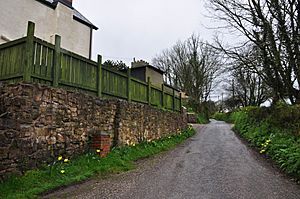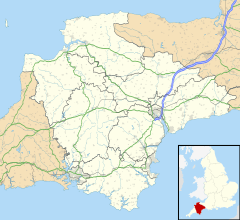Clayhanger, Devon facts for kids
Quick facts for kids Clayhanger |
|
|---|---|
 A lane in the village |
|
| Population | 127 (2011 UK Census) |
| OS grid reference | ST022230 |
| District | |
| Shire county | |
| Region | |
| Country | England |
| Sovereign state | United Kingdom |
| Post town | TIVERTON |
| Postcode district | EX16 7N |
| Police | Devon and Cornwall |
| Fire | Devon and Somerset |
| Ambulance | South Western |
| EU Parliament | South West England |
| UK Parliament |
|
Clayhanger is a small village, also known as a hamlet, found in the beautiful county of Devon, England. It is part of the Mid Devon area. In 2011, only 127 people lived here. This makes Clayhanger a very quiet and peaceful place to live.
Contents
Discovering the Roman Fort at Clayhanger
Did you know that Clayhanger is very close to an ancient Roman fort? This fort is located near Cudmore Farm. It sits on a hill overlooking a small stream called the River Batherm. Most of the fort is actually in the nearby village of Bampton.
Why is this Roman Fort Special?
This Roman fort is really important. It is a scheduled monument. This means it's a special historical site protected by law. It's considered the best example of a Roman fort still in good condition in the whole south west of England.
What Does the Fort Look Like?
The fort is shaped like a rectangle. It measures about 100 meters across on each side. It has a large earth wall, called a rampart, which is 8 meters high. There are also four deep ditches around the outside. These features helped to protect the fort from enemies.
Clues from the Past
If you look closely at the ground, you might see cropmarks. These are patterns in crops or grass that show where old buildings used to be. Inside the fort, these cropmarks probably show where Roman buildings once stood. People have also found pieces of Roman roof tiles and special pottery called samian ware at the site. These finds help us learn more about the Romans who lived there long ago.


